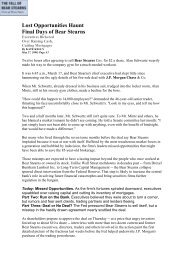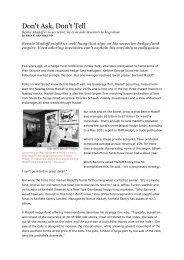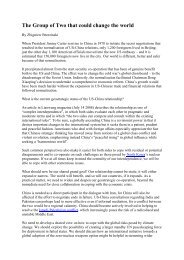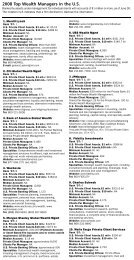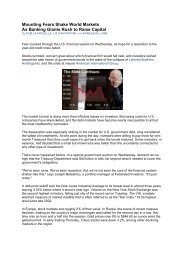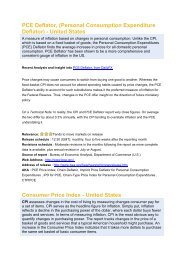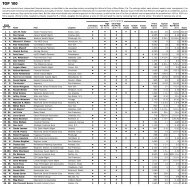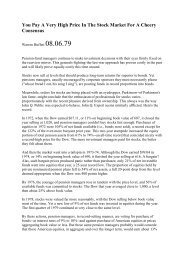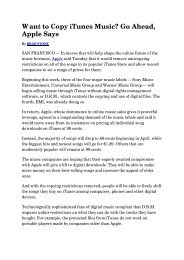As Credit Crisis Spiraled, Alarm Led to Action - Morningbull
As Credit Crisis Spiraled, Alarm Led to Action - Morningbull
As Credit Crisis Spiraled, Alarm Led to Action - Morningbull
You also want an ePaper? Increase the reach of your titles
YUMPU automatically turns print PDFs into web optimized ePapers that Google loves.
<strong>As</strong> <strong>Credit</strong> <strong>Crisis</strong> <strong>Spiraled</strong>, <strong>Alarm</strong> <strong>Led</strong> <strong>to</strong><br />
<strong>Action</strong><br />
By JOE NOCERA<br />
This article was reported by Andrew Ross Sorkin, Diana B. Henriques,<br />
Edmund L. Andrews and Joe Nocera. It was written by Mr. Nocera.<br />
“Panic can cause a prudent person <strong>to</strong> do rational things that can contribute<br />
<strong>to</strong> the failure of an institution.” — William A. Ackman of the hedge fund<br />
Pershing Square Capital Management.<br />
It was early on Wednesday, Sept. 17, when executives at Pershing Square,<br />
Bill Ackman’s hedge fund, began getting nervous calls and e-mail messages<br />
from inves<strong>to</strong>rs. Mr. Ackman, 42, has been a <strong>to</strong>p Wall Street player for 15<br />
years, making his clients — and himself — billions of dollars.<br />
But now, Mr. Ackman and his colleagues were taken aback by what they<br />
were hearing. His big inves<strong>to</strong>rs were worried about all of the Pershing assets<br />
held by Goldman Sachs, the blue-chip investment bank, whose s<strong>to</strong>ck had<br />
come under siege.<br />
Never mind that Goldman kept Pershing’s assets in a segregated account,<br />
and that the money was safe. And never mind that Mr. Ackman believed<br />
Goldman was the world’s best-run investment bank and would come<br />
through the credit crisis unscathed.<br />
Pershing inves<strong>to</strong>rs still feared their money might be exposed. Mr. Ackman<br />
advised Goldman executives <strong>to</strong> do something <strong>to</strong> res<strong>to</strong>re confidence — such<br />
as getting an infusion of capital from Warren E. Buffett, the billionaire<br />
inves<strong>to</strong>r. And while Mr. Ackman kept his assets at Goldman, he hurriedly<br />
set up accounts at three other institutions — just in case things got much<br />
worse.<br />
Pershing had more faith than most. Up and down Wall Street, hedge funds<br />
with billions of dollars at Goldman and Morgan Stanley, another s<strong>to</strong>ried<br />
investment bank, were frantically pulling money out and looking for safer<br />
havens.
Panic was spreading on two of the scariest days ever in financial markets,<br />
and the biggest inves<strong>to</strong>rs — not small inves<strong>to</strong>rs — were panicking the most.<br />
Nobody was sure how much damage it would cause before it ended.<br />
This is what a credit crisis looks like. It’s not like a s<strong>to</strong>ck market crisis,<br />
where the scary plunge of s<strong>to</strong>cks is obvious <strong>to</strong> all. The credit crisis has<br />
played out in places most people can’t see. It’s banks refusing <strong>to</strong> lend <strong>to</strong><br />
other banks — even though that is one of the most essential functions of the<br />
banking system. It’s a loss of confidence in seemingly healthy institutions<br />
like Morgan Stanley and Goldman — both of which reported profits even as<br />
the pressure was mounting. It is panicked hedge funds pulling out cash. It is<br />
frightened inves<strong>to</strong>rs protecting themselves by buying credit-default swaps<br />
— a financial insurance policy against potential bankruptcy — at prices 30<br />
times what they normally would pay.<br />
It was this 36-hour period two weeks ago — from the morning of<br />
Wednesday, Sept. 17, <strong>to</strong> the afternoon of Thursday, Sept. 18 — that spooked<br />
policy makers by opening fissures in the worldwide financial system.<br />
In their rush <strong>to</strong> do something, and do it fast, the Federal Reserve chairman,<br />
Ben S. Bernanke, and Treasury Secretary Henry M. Paulson Jr. concluded<br />
the time had come <strong>to</strong> use the “break the glass” rescue plan they had been<br />
developing. But in their urgency, they bypassed a crucial step in<br />
Washing<strong>to</strong>n and fashioned their $700 billion bailout without political<br />
spadework, which led <strong>to</strong> a resounding rejection this past Monday in the<br />
House of Representatives.<br />
That Thursday evening, however, time was of the essence. In a hastily<br />
convened meeting in the conference room of the House speaker, Nancy<br />
Pelosi, the two men presented, in the starkest terms imaginable, the outline<br />
of the $700 billion plan <strong>to</strong> Congressional leaders. “If we don’t do this,” Mr.<br />
Bernanke said, according <strong>to</strong> several participants, “we may not have an<br />
economy on Monday.”<br />
Setting the Stage<br />
Wall Street executives and federal officials had known since the previous<br />
weekend that it was likely <strong>to</strong> be a difficult week.
With the government refusing <strong>to</strong> offer the same financial guarantees that<br />
helped save Bear Stearns, Fannie Mae and Freddie Mac, efforts on Saturday<br />
<strong>to</strong> find a buyer for Lehman Brothers had failed.<br />
Sunday was spent preparing <strong>to</strong> deal with Lehman’s bankruptcy, which was<br />
announced Monday morning. Merrill Lynch, fearing it would be next, had<br />
agreed <strong>to</strong> be bought by Bank of America. The American International Group<br />
was near collapse. (It would be rescued with an $85 billion loan from the<br />
Federal Reserve on Tuesday evening.)<br />
With government policy makers appearing <strong>to</strong> careen from crisis <strong>to</strong> crisis,<br />
the Dow Jones industrial average plunged 504 points on Monday, Sept. 15.<br />
Panic was in the air.<br />
At those weekend meetings, Wall Street executives and federal officials<br />
talked about the possibility of contagion — that the Lehman bankruptcy<br />
might set off so much fear among inves<strong>to</strong>rs that the market “would pivot <strong>to</strong><br />
the next weakest firm in the herd,” as one federal official put it.<br />
That firm, everyone knew, was likely <strong>to</strong> be Morgan Stanley, whose s<strong>to</strong>ck had<br />
been dropping since the previous Monday, Sept. 8. Within three hours on<br />
Tuesday, Sept. 16, Morgan Stanley shares fell another 28 percent, and the<br />
rising cost of its credit-default swaps suggested inves<strong>to</strong>rs were predicting<br />
bankruptcy.<br />
To allay the panic, the firm decided <strong>to</strong> report earnings a day early — after<br />
the market closed Tuesday afternoon instead of Wednesday morning. The<br />
profit was terrific — $1.425 billion, just a 3 percent decline from 2007 —<br />
and the thinking was that would give inves<strong>to</strong>rs the night <strong>to</strong> absorb the good<br />
news.<br />
“I am hoping that this will generally help calm the market,” Morgan<br />
Stanley’s chief financial officer, Colm A. Kelleher, said in an interview late<br />
that afternoon. “These markets are behaving irrationally. There’s a lot of<br />
fear.”<br />
The Spreading Contagion<br />
But contagion was already spreading. The problem posed by the Lehman<br />
bankruptcy was not the losses suffered by hedge funds and other inves<strong>to</strong>rs
who traded s<strong>to</strong>cks or bonds with the firms. <strong>As</strong> federal officials had predicted,<br />
that turned out <strong>to</strong> be manageable. (That was one reason the government did<br />
not step in <strong>to</strong> save the firm.)<br />
The real problem was that a handful of hedge funds that used the firm’s<br />
London office <strong>to</strong> handle their trades had billions of dollars in balances<br />
frozen in the bankruptcy.<br />
Diamondback Capital Management, for instance, a $3 billion hedge fund,<br />
<strong>to</strong>ld its inves<strong>to</strong>rs that 14.9 percent of its assets were locked up in the<br />
Lehman bankruptcy — money it could not extract. A number of other hedge<br />
funds were in the same predicament. (When called for comment,<br />
Diamondback officials did not respond.)<br />
<strong>As</strong> this news spread, every other hedge fund manager had <strong>to</strong> worry about<br />
whether the balances they had at other Wall Street firms might suffer a<br />
similar fate. And Morgan Stanley and Goldman Sachs were the two biggest<br />
firms left that served this back-office role. That is why Mr. Ackman’s<br />
inves<strong>to</strong>rs were calling him. And that is what caused hedge funds <strong>to</strong> pull<br />
money out of Morgan Stanley and Goldman Sachs, hedge their exposure by<br />
buying credit-default swaps that would cover losses if either firm couldn’t<br />
pay money they owed — or do both.<br />
It was fear, not greed, that was driving everyone’s actions.<br />
Breaking the Buck<br />
There was another piece of bad news spooking inves<strong>to</strong>rs — and government<br />
officials. On Tuesday, the Reserve Primary Fund, a $64 billion money<br />
market fund, and two smaller, related funds, revealed that they had “broken<br />
the buck” and would pay inves<strong>to</strong>rs no more than 97 cents on the dollar.<br />
Money market funds serve a critical role in greasing the wheels of<br />
commerce. They use inves<strong>to</strong>rs’ money <strong>to</strong> make short-term loans, known as<br />
commercial paper, <strong>to</strong> big corporations like General Mo<strong>to</strong>rs, I.B.M. and<br />
Microsoft. Commercial paper is attractive <strong>to</strong> money market funds because it<br />
pays them a higher interest rate than, say, United States Treasury bills, but<br />
is still considered relatively safe.
A run on money funds could force fund managers <strong>to</strong> shy away from<br />
commercial paper, fearing the loans were no longer safe. One reason given<br />
by the Reserve Primary Fund for breaking the buck was that it had bought<br />
Lehman commercial paper with a face value of $785 million that was now<br />
worth little because of its bankruptcy. If money market funds became<br />
fearful of buying commercial paper, that would make it far more difficult for<br />
companies <strong>to</strong> raise the cash needed <strong>to</strong> pay employees, for instance. At that<br />
point, it would not just be the credit markets that were frozen, but<br />
commerce itself.<br />
Just as important, in the eyes of federal officials, was that money market<br />
funds had long been viewed by inves<strong>to</strong>rs as akin <strong>to</strong> bank accounts — a safe<br />
place <strong>to</strong> s<strong>to</strong>re cash and earn interest on that money. Despite lacking federal<br />
deposit insurance, these funds held $3.4 trillion in assets.<br />
“Breaking the buck was the Rubicon,” said a federal official. “This was the<br />
first time in the crisis that you could see s<strong>to</strong>ries talking about how it was<br />
affecting real people.”<br />
Since that Monday, big institutional inves<strong>to</strong>rs — like pension funds and<br />
college endowments — had been pulling money out of money funds. On<br />
Tuesday, individual inves<strong>to</strong>rs joined the stampede.<br />
At the Investment Company Institute, the trade group for the mutual fund<br />
industry, executives had organized a conference call that week with <strong>to</strong>plevel<br />
fund executives and government officials.<br />
“We were saying <strong>to</strong> Treasury and the Fed, at a very high level: Pay attention<br />
<strong>to</strong> this issue. This will have an impact,” recalled Greg Ahern, the group’s<br />
chief communication officer.<br />
But government officials moni<strong>to</strong>ring the crisis did not need the warning.<br />
They were already watching money fund outflows with alarm.<br />
Surprisingly, s<strong>to</strong>ck inves<strong>to</strong>rs — feeling better because of the government’s<br />
A.I.G. rescue plan — either did not comprehend or ignored the growing<br />
chaos in credit markets; the Dow actually rose 141.51 points on Tuesday.<br />
A Dark Day
The respite was brief. Wednesday, Sept. 17, was one of those dark, ugly<br />
market days that offers not even a glimmer of hope.<br />
Fearing the worst, Alex Ehrlich, the global head of prime services at the<br />
Swiss bank UBS, arrived at work in New York at 5 a.m. and immediately<br />
started putting out fires. Because he ran the firm’s prime brokerage unit,<br />
clients were calling <strong>to</strong> see whether their money was safe.<br />
“We were being flooded with client requests <strong>to</strong> move positions, and the<br />
funding markets, which are critically important <strong>to</strong> prime brokers, were<br />
extremely volatile,” he said.<br />
Within seconds of the market opening, the Dow was down 160 points.<br />
Among the big losers was Morgan Stanley. Despite the strong earnings it<br />
had disclosed late Tuesday, its s<strong>to</strong>ck continued <strong>to</strong> plummet. By noon, the<br />
Dow was down 330 points. It rallied in the afternoon, but went in<strong>to</strong> free fall<br />
in the last 45 minutes, closing down 449 points.<br />
And that was just what inves<strong>to</strong>rs could see. Behind the scenes, the credit<br />
markets had almost completely frozen up. Banks were refusing <strong>to</strong> lend <strong>to</strong><br />
other banks, and spreads on credit default swaps on financial s<strong>to</strong>cks — the<br />
price of insuring against bankruptcy — veered in<strong>to</strong> uncharted waters.<br />
Moreover, the drain on money funds continued. By the end of business on<br />
Wednesday, institutional inves<strong>to</strong>rs had withdrawn more than $290 billion<br />
from money market funds. In what experts call a “flight <strong>to</strong> safety,” inves<strong>to</strong>rs<br />
were taking money out of s<strong>to</strong>cks and bonds and even money market funds<br />
and buying the safest investments in the world: Treasury bills. <strong>As</strong> a result,<br />
yields on short-term Treasury bills dropped close <strong>to</strong> zero. That was almost<br />
unheard of.<br />
In the s<strong>to</strong>ck market, Mr. Ehrlich of UBS was horrified by the plunge of<br />
Morgan Stanley’s shares, given the stellar earnings. “It felt like there was no<br />
ground beneath your feet,” he said. “I didn’t know where it was going <strong>to</strong><br />
end.”<br />
A Chief Executive’s Anger
Neither did Morgan Stanley’s chief executive, John J. Mack. A week before,<br />
his firm’s s<strong>to</strong>ck was trading in the mid-40s. On Wednesday, it fell from<br />
$28.70 a share <strong>to</strong> $21.75 — down about 50 percent over a week.<br />
“There is no rational basis for the movements in our s<strong>to</strong>ck or credit default<br />
spreads,” Mr. Mack wrote in a companywide memo on Wednesday. Mr.<br />
Mack lashed out at the people he felt were responsible for Morgan Stanley’s<br />
woes: the short-sellers, who profit by betting that a s<strong>to</strong>ck will fall.<br />
Like most Wall Street firms, Morgan Stanley over the years had handled<br />
transactions for short-sellers, despite complaints by other companies that<br />
short-sellers unfairly ganged up on their s<strong>to</strong>ck. Nevertheless, Mr. Mack<br />
called Sena<strong>to</strong>r Charles E. Schumer, Democrat of New York, and Chris<strong>to</strong>pher<br />
Cox, the chairman of the Securities and Exchange Commission, pressing<br />
them <strong>to</strong> ban short-selling.<br />
He raged about what he viewed as a concerted effort <strong>to</strong> drive down the<br />
firm’s s<strong>to</strong>ck. “He got emotional,” says one person who knows him well.<br />
Meeting with staff members Thursday morning as the s<strong>to</strong>ck plunged further<br />
— hitting a low of $11.70 midday — Mr. Mack said: “Listen. I know<br />
everybody is anxious about the s<strong>to</strong>ck price. I’m not selling any shares, and<br />
neither is my team. But I understand if you’re nervous and want <strong>to</strong> sell<br />
some shares.” Some did. (The company said fewer than one-third of<br />
employees sold s<strong>to</strong>ck that day.)<br />
At the same time, Mr. Mack began talks <strong>to</strong> merge with Wachovia, and called<br />
other banks about possible combinations. He also called Mr. Buffett for<br />
advice, while aides in Tokyo contacted Mitsubishi UFJ, Japan’s biggest<br />
lender, hoping <strong>to</strong> raise additional capital.<br />
Run on a Fund<br />
Even as s<strong>to</strong>cks tanked, turmoil was worsening in money markets. On<br />
Wednesday evening, Paul Schott Stevens, the head of the Investment<br />
Company Institute, learned about a problem with another money fund.<br />
“This time it was Putnam,” recalled Mr. Stevens, referring <strong>to</strong> the Bos<strong>to</strong>nbased<br />
mutual fund company Putnam Investments.
Out of the blue, it seemed, there was a run on the $12.3 billion Putnam<br />
Prime Money Market Fund. That meant the money fund contagion was<br />
spreading. Because of huge withdrawals, Putnam decided it had <strong>to</strong> shut the<br />
fund, and distribute the cash <strong>to</strong> shareholders. If it did not, the first ones out<br />
the door would get a better deal than the laggards.<br />
Executives of the Investment Company Institute and fund officials<br />
scrambled <strong>to</strong> find a solution that would keep Putnam from having <strong>to</strong> take<br />
that step, but they failed. On Thursday, Putnam shuttered the fund. (After<br />
the government rescue plan was announced, it sold the fund, intact, <strong>to</strong><br />
another company, and inves<strong>to</strong>rs did not lose a penny.)<br />
The Fed Takes <strong>Action</strong><br />
Ben Bernanke had spent his career studying financial crises. His first<br />
important work as an economist had been a study of the events that led <strong>to</strong><br />
the Great Depression. Along with several economists, he came up with a<br />
phrase, “the financial accelera<strong>to</strong>r,” which described how deteriorating<br />
market conditions could speed until they became unmanageable.<br />
To an alarming degree, the credit crisis had played out as his academic work<br />
predicted. But his research also led Mr. Bernanke <strong>to</strong> the view that<br />
“situations where crises have really spiraled out of control are where the<br />
central bank has been on the sideline,” according <strong>to</strong> Mark Gertler, a New<br />
York University economist who has collaborated with Mr. Bernanke on<br />
some papers.<br />
Mr. Bernanke had no intention of keeping the Fed on the sidelines. <strong>As</strong> the<br />
crisis deepened, it <strong>to</strong>ok more aggressive steps. It added liquidity <strong>to</strong> the<br />
system. It opened the discount window — the emergency lending facility<br />
that had been reserved for troubled banks — <strong>to</strong> investment banks. It also<br />
agreed <strong>to</strong> absorb up <strong>to</strong> $29 billion in Bear Stearns losses and made an $85<br />
billion loan <strong>to</strong> keep A.I.G. afloat.<br />
Representative Barney Frank, the Massachusetts Democrat who leads the<br />
House Financial Services Committee, asked Mr. Bernanke if the Fed had<br />
$85 billion <strong>to</strong> spare. “We have $800 billion,” Mr. Bernanke replied,<br />
according <strong>to</strong> Mr. Frank.
Since the Bear Stearns bailout, Treasury and Fed officials had discussed<br />
what a broad government intervention might look like. Although there were<br />
suggestions for a “bank holiday” — a temporary, nationwide closing of<br />
banks, which had not been done since 1933, <strong>to</strong> stem panicky withdrawals —<br />
Mr. Bernanke and Mr. Paulson dismissed the idea, fearing it would do far<br />
more harm than good by scaring people needlessly. They had both<br />
assembled teams <strong>to</strong> map out drastic rescue plans — the “break the glass”<br />
plans.<br />
Almost from the start, they concluded the best systemic solution was <strong>to</strong> buy<br />
hard-<strong>to</strong>-sell mortgage-backed securities.<br />
On Wednesday morning, during a conference call with other <strong>to</strong>p officials,<br />
including Jean-Claude Trichet, the president of the European Central Bank,<br />
Mr. Bernanke sounded them out on a big government bailout. The other<br />
officials sounded relieved; their main questions were about whether<br />
Congress could act quickly.<br />
That evening, Mr. Bernanke <strong>to</strong>ld Mr. Paulson during a conference call: “You<br />
have <strong>to</strong> go <strong>to</strong> Congress. This is pervasive.” Mr. Paulson agreed.<br />
A Sense of Urgency<br />
By Thursday morning, the need for dramatic action had grown even more<br />
urgent.<br />
In <strong>As</strong>ia, s<strong>to</strong>cks had already closed lower. To quell fears before the opening of<br />
European markets, the Fed and other central banks announced they would<br />
make $180 billion available, in an effort <strong>to</strong> get banks <strong>to</strong> start lending <strong>to</strong> each<br />
other again. The Fed had agreed <strong>to</strong> open its discount window <strong>to</strong> make loans<br />
available <strong>to</strong> money market funds <strong>to</strong> prevent further runs.<br />
But it was <strong>to</strong> little avail.<br />
At 8:30 Thursday morning in the United States, when Mr. Paulson and Mr.<br />
Bernanke reviewed the state of affairs, markets remained roiled. The crisis<br />
was not easing up.<br />
One Bank’s Solution
Lloyd C. Blankfein, Goldman Sachs’s chief executive, had arrived at the<br />
firm’s office on 85 Broad Street just before 7 a.m. Thursday, anticipating<br />
another bad day. The investment bank’s s<strong>to</strong>ck had already been pummeled.<br />
From nearly $250 a share last Oc<strong>to</strong>ber, it had fallen <strong>to</strong> $114.50 on<br />
Wednesday — after hitting a low of $97.78 that day.<br />
One idea he had been exploring was <strong>to</strong> transform Goldman in<strong>to</strong> a bank<br />
holding company. Mr. Mack, meantime, was also considering such a move<br />
for Morgan Stanley, and both were in separate discussions with the Fed.<br />
There was safety in that notion — they would become deposi<strong>to</strong>ry<br />
institutions regulated by the Fed and others — though it also meant they<br />
would not be able <strong>to</strong> pile on as much debt as they had as investment banks.<br />
That would hurt profits. But now profits were less pressing than survival.<br />
Mr. Blankfein accelerated the planning.<br />
By 1 p.m., the Dow had fallen another 150 points — meaning that in a day<br />
and a half it was down nearly 600 points. Goldman’s s<strong>to</strong>ck dropped <strong>to</strong><br />
$85.88, its lowest in nearly six years.<br />
Just then, a prankster piped “The Star-Spangled Banner” over the firm’s<br />
loudspeaker system on the 50th floor. Fixed-income traders s<strong>to</strong>pped and<br />
s<strong>to</strong>od at attention, some with hands on their hearts. Oddly, it was at<br />
precisely that moment that the market — and Goldman’s shares — started<br />
<strong>to</strong> rise.<br />
The traders began <strong>to</strong> cheer.<br />
Curbing Short-Selling<br />
What happened? At 1 p.m. New York time, the Financial Services Authority<br />
in Britain, which regulates that nation’s financial institutions, announced a<br />
ban on short-selling of 29 financial s<strong>to</strong>cks that would last at least 30 days.<br />
“When I saw that, I knew we were about <strong>to</strong> have the mother of all short<br />
squeezes,” said one hedge fund manager. Realizing that the S.E.C. was likely<br />
<strong>to</strong> follow suit, hedge funds began “covering their shorts” — that is, buying<br />
the s<strong>to</strong>cks they had borrowed <strong>to</strong> short, even if it meant taking a loss.
That caused all kinds of s<strong>to</strong>cks <strong>to</strong> begin rising. Sure enough, the S.E.C.<br />
followed suit the next day, placing a temporary short-selling ban on 799<br />
financial s<strong>to</strong>cks.<br />
A few hours later came the second event. At 3:01 CNBC reported the<br />
Treasury and the Fed were planning a giant fund <strong>to</strong> buy <strong>to</strong>xic mortgagebacked<br />
assets from financial institutions. Though there had been hints of<br />
this earlier in the afternoon, and s<strong>to</strong>cks had started rising around 2:30, the<br />
wide dissemination set off a huge rally. In a 45-minute burst, the Dow<br />
gained another 300 points, closing the day up 410 points.<br />
Meeting on Capi<strong>to</strong>l Hill<br />
Two hours later, Mr. Paulson and Mr. Bernanke trooped up <strong>to</strong> Capi<strong>to</strong>l Hill<br />
for a somber session with Congressional leaders. “That meeting was one of<br />
the most as<strong>to</strong>unding experiences I’ve had in my 34 years in politics,”<br />
Sena<strong>to</strong>r Schumer recalled.<br />
<strong>As</strong> the members of Congress and their aides listened, the two laid out their<br />
plan. They would begin offering federal insurance <strong>to</strong> money market funds<br />
immediately, in order <strong>to</strong> s<strong>to</strong>p the run on money funds.<br />
In addition, the S.E.C. would institute a ban on short-selling of financial<br />
s<strong>to</strong>cks. Although Treasury officials concede that the move was mostly<br />
symbolic — inves<strong>to</strong>rs can still buy put options that have the same effect as<br />
shorting s<strong>to</strong>cks — they did it mainly “<strong>to</strong> scare the hell out of everybody,” as<br />
one official put it.<br />
After Mr. Bernanke made his remark about the possibility that there might<br />
not be an economy on Monday without this plan, you could hear a pin drop.<br />
“I gulped,” Mr. Schumer said.<br />
Congressional leaders were nearly unanimous in saying that it needed <strong>to</strong> be<br />
done for the good of the country. Representative John A. Boehner of Ohio —<br />
the Republican House leader who a week later would lead the revolt against<br />
the plan — said it was time <strong>to</strong> put politics aside and move quickly, according<br />
<strong>to</strong> several participants. (An aide <strong>to</strong> Mr. Boehner denied that he voiced<br />
support for the plan, only that he made a plea for cooperation.)
Hearing that Mr. Bernanke and Mr. Paulson wanted legislation passed in a<br />
matter of days, the Senate majority leader, Harry Reid, expressed<br />
as<strong>to</strong>nishment. “This is the United States Senate,” he said. “We can’t do it in<br />
that time frame.” His Republican counterpart, Sena<strong>to</strong>r Mitch McConnell,<br />
replied, “This time we can.”<br />
He was wrong. After a week of wrangling, political infighting and<br />
compromise, the House on Monday voted down the legislation. The Dow<br />
plunged nearly 778 points, and credit markets had worsened, with interest<br />
rates rising and loans becoming harder <strong>to</strong> obtain.<br />
Two weeks after Mr. Paulson and Mr. Bernanke made their appeal, the<br />
House is likely <strong>to</strong> try again.




